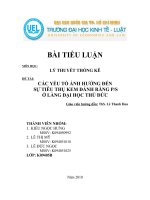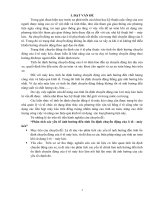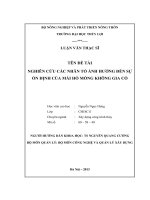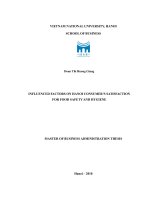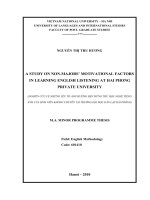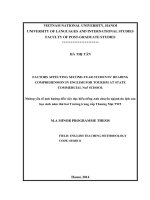Influenced factors on Hanoi consumer's satisfaction for safety and hygiene= Các yếu tố ảnh hưởng đến sự hài lòng của người tiêu dùng Hà Nội về vấn đề vệ sinh an toàn thực phẩm
Bạn đang xem bản rút gọn của tài liệu. Xem và tải ngay bản đầy đủ của tài liệu tại đây (1.62 MB, 112 trang )
VIETNAM NATIONAL UNIVERSITY, HANOI
SCHOOL OF BUSINESS
Doan Thi Huong Giang
INFLUENCED FACTORS ON HANOI CONSUMER’S SATISFACTION
FOR FOOD SAFETY AND HYGIENE
MASTER OF BUSINESS ADMINISTRATION THESIS
Hanoi – 2010
VIETNAM NATIONAL UNIVERSITY, HANOI
SCHOOL OF BUSINESS
Doan Thi Huong Giang
INFLUENCED FACTORS ON HANOI CONSUMER’S SATISFACTION
FOR FOOD SAFETY AND HYGIENE
Major: Business Administration
Code
: 60 34 05
MASTER OF BUSINESS ADMINISTRATION THESIS
Supervisors:
1. Dr. Pham Quy Long
2. Dr. Nguyen Thi Phi Nga
Hanoi – 2010
vi
TABLE OF CONTENTS
ACKNOWLEDGEMENTS i
ABSTRACT ii
TÓM T
ẮT iv
TABLE OF CONTENTS vi
LIST OF FIGURES viii
LIST OF TABLES ix
Introduction 1
1. Necessity of the research 1
2. Research Objectives 1
3. Research questions 2
4. Scope of the research 2
5. Research methodology 3
6. Limitations 3
7. Contributions of the research 3
8. Expected results 4
9. Suggestions for future research 4
10. Research structure 4
Chapter 1: Literature Review 6
1.1. Consumer’s satisfaction definition 6
1.2. Theories of consumer’s satisfaction interpretations 9
1.2.1. Psychological interpretation 10
1.2.2. Economic interpretations 16
1.2.3. Sociological interpretation 22
1.3. Discussion of related research 25
Chapter 2: Research model and Hypothesis 30
2.1. Research model 30
2.2. Description of factors in the model 32
2.2.1. Media 32
2.2.2. Product’s quality 35
2.2.3. Product’s price 38
vii
2.2.4. Product’s label 42
2.2.5. Compliance level of food safety and hygiene 44
2.3. Hypothesis of correlation among factors 45
Chapter 3: Research Methodology 48
3.1. Research purpose 48
3.2. Research approach 51
3.3. Measurement index of factors 52
3.4. Sample selection 55
3.5. Data collection 57
3.6. Data analysis 59
3.6.1. Validity 59
3.6.2. Reliability 60
Chapter 4: Data presentation and results 62
4.1. Data presentation 62
4.2. Some results 76
4.2.1. The most important factors of Hanoi consumer’s satisfaction regarding food
safety and hygiene 76
4.2.2. Consumer’s satisfaction regarding food safety and hygiene by influenced factors
79
4.2.3. Hypothesis tested 81
CONCLUSION 85
REFERENCES 87
APPENDICES 101
Appendix A: Survey questionnaire for Chinsu sauce product 101
Appendix B: Survey questionnaire for Dr. Thanh product 104
viii
LIST OF FIGURES
Figure 1.1: Loyalty in different situation of satisfaction and attitude 8
Figure 1.2: Interpretations of consumer’s satisfaction/dissatisfaction 12
Figure 1.3: Consumer surplus 18
Figure 1.4: Hypothetical utility curves 21
Figure 1.5: Classification of consumer satisfaction/dissatisfaction research 26
Figure 2.1: The structural model of influenced factors on consumer’s satisfaction on
food safety and hygiene 32
Figure 2.2: Pricing strategies matrix 39
Figure 4.1: Gender in Dr. Thanh and Chinsu sauce survey samples 63
Figure 4.2: Frequency of using products in the recent two surveys 67
Figure 4.3: Willingness to introduce products to others 68
Figure 4.4: Satisfaction level of respondents with Chinsu sauce product 72
Figure 4.5: Satisfaction level of respondents with Dr. Thanh product 76
Figure 4.6: The importance of influenced factors in Dr. Thanh survey 77
Figure 4.7: The importance of influenced factors in Chinsu survey 78
Figure 4.8: Respondents' satisfaction regarding food safety and hygiene by
influenced factors in Dr. Thanh survey 80
Figure 4.9: Respondents' satisfaction regarding food safety and hygiene by
influenced factors in Chinsu survey 81
ix
LIST OF TABLES
Table 3.1: Assessing the importance of influenced factors of consumer’s satisfaction
53
Table 3.2: Assessing the satisfaction level of consumer’s satisfaction regarding food
safety and hygiene 54
Table 4.1: Age category in the two surveys 64
Table 4.2: Job positions of the samples in the two surveys 65
Table 4.3: Monthly income of the samples in the two surveys 65
Table 4.4: How long the respondents have used products in the two surveys 66
Table 4.5: Media factor in Chinsu survey 69
Table 4.6: Quality factor in Chinsu survey 70
Table 4.7: Price factor in Chinsu survey 70
Table 4.8: Label factor in Chinsu survey 71
Table 4.9: Label factor in Chinsu survey 71
Table 4.10: Media factor in Dr. Thanh survey 73
Table 4.11: Quality factor in Dr. Thanh survey 73
Table 4.12: Price factor in Dr. Thanh survey 74
Table 4.13: Label factor in Dr. Thanh survey 74
Table 4.14: Label factor in Dr. Thanh survey 75
Table 4.15: Significance of influenced factors in Chinsu survey 82
Table 4.16: Significance of influenced factors in Dr. Thanh survey 83
1
Introduction
1. Necessity of the research
With annual growth rate of 1.2%, Hanoi population reaches
approximately 6.7 million people in 2010, the demand for food is increasing
more than ever before despite the fact that land for agriculture is getting
smaller due to urbanization. Therefore, food consumption situation becomes
more complex and hard to control.
Nowadays, many cases of un-safety and in-hygiene food have been
revealed and punished by food management authorities including Ministry of
Health, Ministry of Industry and Trade and Ministry of Agriculture and Rural
development. As the result, Hanoi consumer’s satisfaction has been affected
and their confidence in food safety and hygiene has been being lost.
However, there are still some foods brands that take care of consumers’
health and commit to provide only safe and qualified products would be
awarded consumers’ trust.
In such context, I decide to choose the topic: “Influenced factors on
Hanoi consumer’s satisfaction for food safety and hygiene”, to identify key
factors influencing consumer’s satisfaction and to propose solutions for
marketers in enhancing Hanoi consumer’s satisfaction with food industry.
2. Research Objectives
Study definition and theory of consumer’s satisfaction
Study factors influencing consumer’s satisfaction in Hanoi
regarding food safety and hygiene
2
Propose some solutions for enhancing Hanoi consumer’s
satisfaction regarding food safety and hygiene.
3. Research questions
In order to achieve the objectives of the thesis, the author of thesis will
try to answer the following questions:
What is definition of consumer’s satisfaction?
What are theories of consumer’s satisfaction?
What is research model for the thesis?
Which influenced factors are selected for the research model?
Which research methodology is applied for the thesis?
Which products are selected as sample for the research?
What are solutions for enhancing Hanoi consumer’s satisfaction
regarding food safety and hygiene?
4. Scope of the research
This thesis focuses on the most influenced factors on Hanoi
consumer’s satisfaction for food safety and hygiene.
For food safety and hygiene issue, food is a broad term which can be
classified into import foods and domestic food; fresh food and processed
food; etc. In scope of this thesis, the author selects two domestic products as
research objects in stead of food in general. They are fish sauce Chinsu and
herbal tea Dr. Thanh. The research is conducted in Hanoi area, which targets
to those who often buy food. They are officers, housewives, students, etc.
3
Thereby, the solutions for enhancing Hanoi consumer’s satisfaction
regarding food safety and hygiene will be proposed, based on the research
conduction and analysis.
5. Research methodology
Thesis is used methodology of researching the secondary data, primary
data; conducting qualitative (by interviewing respondents in Hanoi ) and
quantitative by survey regarding their opinions about factors affecting their
satisfaction for food safety and hygiene, focusing two selected products as
research objects.
6. Limitations
The first limit of this thesis is the scope of work, which focuses
on only two products, not covering all kind of foods in the
market.
The second one is the research methodology using quantitative
by survey, with limited observations in the sample. Due to
limited time and budget, the author only conduct the survey in
small scale of approximately 200 observations each survey,
which target to sample of officers, students, housewives, etc. 189
respondents joined Dr. Thanh survey and 198 respondents joined
Chinsu sauce survey. Therefore, the result will be relatively
precisely estimated.
7. Contributions of the research
This thesis presents the updated theory of consumer’s satisfaction. This
theory is good references for researchers, marketers, and leaders for their
business.
4
On the practice side, some influencing factors on Hanoi consumer’s
satisfaction their impacts to consumer’s satisfaction regarding food safety and
hygiene will be discovered as a good source for marketers and leaders in
order to accelerate consumer’s satisfaction regarding food safety and hygiene.
8. Expected results
The study expects to show the following findings:
Bring systematic knowledge and theory of consumer’s
satisfaction.
Provide a thorough analysis the research result through
qualitative and quantitative methodology conducted for two
selected products in Hanoi regarding on food safety and hygiene.
Propose the lessons for marketers in enhancing Hanoi
consumer’s satisfaction regarding food safety and hygiene.
9. Suggestions for future research
Further study can also be carried out to consumer’s satisfaction on food
safety and hygiene in Vietnam with variety of products will be chosen for the
research objects.
10. Research structure
In chapter 1 the nature of consumer’s satisfaction/dissatisfaction is first
explored. The literature dealing with the conceptualization of consumer’s
satisfaction/dissatisfaction is surveyed, followed by a discussion of research
investigating factors influencing consumer’s satisfaction/dissatisfaction.
Based on the survey of the literature on consumer’s
satisfaction/dissatisfaction, a structural model of consumer’s satisfaction and
5
Chinese cultural value is proposed. Chapter 2 contains the main theoretical
part of the work. With respect to each theoretical part of the work, with
respect to each theoretical dimension of Chinese cultural values, potential
marketing implications are presented. Each component of the model as well
as related hypotheses are presented and discussed.
In chapter 3, the methods of collecting empirical data for testing the
model and hypotheses are discussed in parallel with the problems related to
measurements instruments. Results of the pilot survey are also presented and
discussed.
Chapter 4 content the analysis used in testing the model and
hypotheses.
The concluding part serves to summarize the research, and draw
conclusions based on the research result against the hypotheses and
objectives of the study. It also offers implications and recommendations for
further research.
6
Chapter 1: Literature Review
1.1. Consumer’s satisfaction definition
Before discussing the conceptualization of consumer’s satisfaction, it is
useful to consider what “satisfaction” is and how “satisfaction” differs from
“attitude”. This section first considers this issue, followed by a discussion of
the terms “consumer’s satisfaction” and “consumer dissatisfaction”, and
concludes with the definition that is used in this research.
Consumer’s satisfaction and consumer attitude
In order to reach a satisfactory definition of consumer’s satisfaction, it
is necessary to distinguish between consumer’s satisfaction and attitude.
There are quite a number of definitions of the term “consumer’s satisfaction”;
amongst the earliest, Howard and Sheth (1969) define consumer’s
satisfaction as “the buyer’s cognitive state of being adequately or
inadequately rewarded in a buying situation for the sacrifice he has
undergone’. From the marketing aspect, Andreasen (1977) stated:
“Business, government, and other nonprofit organizations need
measures of how well products and services (performance) are meeting client
needs and wants so that they can enhance their own and/or society’s well-
being. The extent to which these needs and wants are met has come to be
called consumer’s satisfaction/dissatisfaction…”
Though being different, these definitions implicitly contain four
common elements (Day 1975):
1- The performance of the product or service as perceived by the
consumer
7
2- The expectations of performance which the consumer has
3- The perceived costs or “sacrifices” involved in making the purchase
and using the product/service.
4- The time at which the satisfaction with the product/service is
assessed.
Triandis (1971), summarizing central ideas used by other attitude
theorists, defined attitude as “an idea charged with emotion which
predisposes a class of actions to a particular class of social situations”. His
definition suggests the three principle components of attitudes:
1- The cognitive component is the IDEA which a person, as an
evaluator, perceives in a given context.
2- The affective component is the EMOTION which charges the idea
so that a person has positive affects (like) or negative affect
(dislike) toward an object.
3- The behavior component is the PREDISPOSITION TO ACTION,
such as shopping at a department store, buying a shirt or hiring a
car.
Pfaff (1977) suggested that consumer’s satisfaction can be denoted, in
past, by all components of attitudes. The cognitive component indicates the
confirmation or disconfirmation of expectation and performance of the
product; the affective component indicates whether the consumer is satisfied
or dissatisfied with the product; and the conative component, whether to stop
or arouse future purchases in post-purchase situations. Therefore, satisfaction
is not only an attitude; it is a richer concept than attitude.
8
Tse (1980) suggested that satisfaction adds additional dimensions to
the explanation of a consumer’s information receptivity, choice behavior and
brand loyalty. Taking brand loyalty as an example, he presented the
interaction of attitude and satisfaction in a contingency table as in Figure 1.1.
Source: Tse (1980)
Figure 1.1: Loyalty in different situation of satisfaction and attitude
Cell 1 represents the situation where the consumer likes the product or
service and is satisfied with it. In this situation, the consumer has stable
loyalty and will continue using the product/service. Cell 2 presents the
situation where the consumer likes the product/service but is dissatisfied with
it. This situation may be caused by a sudden decline in the performance of the
product/service. Lacking confidence in the product/service, the consumer has
unstable loyalty and will continue purchasing the product/service only when
there is a guarantee of performance or quality. Cell 3 represents the situation
where the consumer does not like the product, but is still satisfied with it only
9
because it meets certain basic demands, for example low price. In this
situation, the consumer has equitable loyalty, no alternative available and is
receptive towards advertisements and sales promotions.
Cell 4 represents the situation where the consumer neither likes the
product/service nor is satisfied with it. This situation is probably caused by
market imperfections such as lack of competition, and time pressure. In this
situation, the consumer has to continue using the product until market
imperfections are relaxed. Therefore, by studying attitude alone, we cannot
account for more detailed differences in the consumer’s loyalty towards
brands.
Consumer’s satisfaction/dissatisfaction is a complex concept.
Throughout this research, it is defined as:
a measurable evaluative attitude
which is derived from the disconfirmation of expectations and perceived
performance of the product consumed or experienced by the consumer. The
level of the expectations and perceived performance are determined by every
aspect of the purchase-consumption process.
1.2. Theories of consumer’s satisfaction interpretations
Since 1976, the term “consumer’s satisfaction/dissatisfaction” has
frequently appeared in the marketing literature. However, as mentioned in the
last section, no consensus on a definition of it has been reached. Hunt (1977)
attributed this situation to one simple reason: many researchers plunged
ahead with measurement problems in consumer’s satisfaction/dissatisfaction
when they had not understood the basic conceptual problems. These
pioneering researchers, who were involved in public-policy affairs inside and
outside government in the United States, could afford only minimal effort to
conceptualize consumer’s satisfaction/dissatisfaction before getting started on
10
the measurement problems. Up to now, consumer’s
satisfaction/dissatisfaction has been interpreted in the following ways (see
Figure 1.2).
1.2.1. Psychological interpretation
A large amount of research has been done by consumer psychologists
and marketing researchers, applying a variety of psychological theories to
explain product evaluation, and to assess satisfaction in the consumer
decision-making context. Theories which have received a considerable
amount of attention in consumer’s satisfaction literature are:
1- Cognitive dissonance
2- Contrast
3- Contrast and assimilation
4- Opponent-process
5- Adaptation-level
6- Equity
These theories provide explanations of how the consumer behaves in
different ways when his perceptions of the performance of a product are at
variance with the perceived expectations of the product (Anderson 1973).
Each theory is discussed below.
Theory of cognitive dissonance Proposed by Festinger (1957), the
cognitive dissonance theory begins with a consideration of two cognitive
elements. If one element does not follow from the other, the two elements
are said to be in dissonance. If the two cognitive elements are in dissonance,
psychological discomfort will motivate the person to reduce dissonance and
achieve consonance in several ways:
11
1- By changing one of the two elements
2- By lowering the importance of the cognitive elements
3- By adding new cognitive elements which will be consonant with the
element in question
4- By making relevant elements irrelevant,
The two cognitive elements may be viewed as the perceived
expectation towards the product before use or consumption, and the
performance of the product. The disconfirmation, if it occurs, will be reduced
(assimilated) by the consumer, who adjusts his perception of the product to be
more consistent with his expectations.
12
Figure 1.2: Interpretations of consumer’s satisfaction/dissatisfaction
Contrast theory The contrast theory of consumer’s satisfaction predicts
consumer reaction in just the opposite way. Instead of reducing dissonance,
the consumer will magnify the difference between expectation and the
performance of the product/service. If the product’s performance exceeds
expectation, he will be highly satisfied, but if the product’s performance falls
below expectation, he will be highly dissatisfied (Day 1977). This implies
that the consumer is very sensitive to unmatched expectations and may react
in an exaggerated way.
Assimilation-contrast theory This theory was introduced by Anderson
(1973) in the context of post-exposure product performance, based on Sherif
and Hovland’s (1961) discussion of assimilation and contrast effect, in
studies of communication effects on attitude change. It has been used to
explain consumer’s satisfaction by applying one or both of the two theories
discussed above. In the case of a moderate level of disconfirmation of
expectation and performance, the consumer will behave according to the
theory of cognitive dissonance. That is, the consumer will try to reduce the
discrepancy by adjusting his perception. In the case of a high level of
disconfirmation which is beyond some “latitude of acceptance”, the
consumer will behave in accordance with the contrast theory, that is, will
magnify the difference between expectation and performance of the product
(Day 1975).
Adaptation-level theory Adaptation-level theory is another theory which is
consistent with expectation and disconfirmation effects on satisfaction. This
theory was originated by Helsen (1964) and applied to consumer’s
satisfaction by Oliver (1980b, 1981). Helsen (1964) simply put his theory as
follows:
13
It posits that one perceives stimuli only in relation to an adapted
standard. The stand is a function of perceptions of the stimulus itself, the
context, and psychological and physiological characteristics of the organism.
Once created, the “adaptation level” served to sustain subsequent evaluations
in that positive and negative deviations will remain in the general vicinity of
one’s original position. Only large impacts on the adaptation level will
change the final tone of the subject’s evaluation. For example, someone who
sees lots of big cars on the road every day will have a different standard for
"big car" than someone who's surrounded by small vehicles.
Opponent-process theory This was originally a theory of motivation
reformulated by Solomon and Corbit (1974) which has been adapted from the
basic physiological phenomena known as homeostasis (Fletcher 1942).
Homeostasis assumes that many hedonic, affective or emotional states, being
away from neutrality and exceeding a threshold level of hedonic feelings, are
automatically opposed by central nervous system mechanisms which reduce
the intensity of the feelings, both pleasant and aversive, to some constant
level (Solomon and Corbit 1974).
Emotional events, such as criticisms or rewards, elicit two sets of
processes. Primary processes, which evoke emotions that are consistent with
the affective tone of the event. Threatening events, such as examinations,
elicit processes that provoke anxiety. Relaxing events, such as meditation,
evoke processes that foster composure. Opponent processes, which evoke
emotions that counter these primary processes. Threatening events elicit
opponent processes that promote composure. Relaxing events evoke
opponent processes that provoke anxiety, and so forth.
14
Several properties differentiate primary and opponent processes. First, most
emotional events will elicit primary processes. Only the more intense events
will elicit opponent processes. Specifically, when the intensity or magnitude
of the primary processes exceeds some threshold, opponent processes are
evoked. Second, the primary process is elicited rapidly but also declines
quickly. The opponent process, in contrast, is evoked more slowly but also
wanes gradually. As a consequence, in response to aversive events,
individuals often experience unpleasant emotions initially that gradually
decline. Indeed, at some point in the trajectory, the opponent processes often
overrides the primary process, and a pleasant emotion is experienced called
an overshoot effect. Positive events can elicit the converse trajectory of
emotions. Third, frequent exposure to a specific event, such as examinations
or meditation, does not significantly affect the magnitude or trajectory of
primary processes. After regular exposure to these events, however, the
opponent process is evoked more rapidly and diminishes more slowly.
Equity theory An early recognition of this theory first came out of research
by Stouffer and his colleagues (1949) in military administration. They
referred to “relative deprivation” (equity) as the reaction to an imbalance or
disparity between what an individual perceives to be the actuality and what
he believes should be the case, especially where his own situation is
concerned. This imbalance or disparity will induce an attitude of satisfaction
or dissatisfaction in him. This led to Homans’ concept of “distributive
justice”, which refers to a condition where an individual’s investments are
balanced by his rewards.
Among other psychologists (Spector 1956; Patchen 1961) who worked
along similar lines, Adams (1963) was the first to adopt the term “equity” to
15
explain his work on the amount of effort expended by production workers.
He stated that “equity exists for a person whenever his perceived job inputs
and/or outcomes stand psychologically in an obverse relation to what he
perceives are the inputs and/or outcomes of others’. In other words, the
perceived inputs (investments or costs) to the job must be in equilibrium with
the perceived benefits (rewards) or the individual will be in a state of
imbalance, and will attempt to reduce the resulting tension. Adams’s
definition differs from his antecedents’ in stressing the concepts of costs and
rewards. It must be realized that another person’s perception that matters
most. It is the individual’s own perception of his situation which continues to
have overriding significance in determining his response pattern. This theory
can be treated as a special case of cognitive dissonance.
In explaining consumer’s satisfaction, a consumer makes his judgment
in a buying decision-making process, by weighing the costs (inputs) and
benefits (outcomes) of the product selected, relative to those rejected. If the
outcomes of this comparison are constant, then the consumer will be
satisfied. Otherwise, the consumer will attempt to achieve equilibrium by
adjusting the perceived costs and benefits of the product selected (Adler and
Robinson 1980). Hence, the costs and benefits of the product selected can be
viewed as performance, while those of the product rejected as expectation.
The outcome of the comparison can be treated as the confirmation or
disconfirmation between expectation and performance.
Huppertz (1979), studying satisfaction associated with shopping,
developed different measures of the inputs and outcomes of consumer and
seller from shopping events. He first gave some examples of the events which
measure outcomes and inputs. Consumer input should be the price paid, or
16
the distance to the store. Consumer outcome could be the time span that the
product lasts, or the amount of help given by advertising. The seller input
could be the amount spent on advertising or the availability of sales persons
to serve the consumer; and the seller outcome could be the profit made, or the
complements from shoppers. These ratios were then compared to give a
measure of equity or inequity which represents consumer’s
satisfaction/dissatisfaction. In such a way Huppertz successfully
discriminated between satisfied and dissatisfied consumers. He used the
ratios to make the concept of equity or inequity (satisfaction or
dissatisfaction) more operationalized. This was indeed a contribution to the
application of equity theory to both the conceptualization and the
measurement of consumer’s satisfaction; however, what is needed is the
development of better measures of inputs and outcomes for specific
situations.
1.2.2. Economic interpretations
Consumer’s satisfaction/dissatisfaction can also be conceptualized in
terms of economic theory. Two branches of economic theory are discussed
here.
Consumer surplus In economic theory, a rational consumer will
allocate his scarce resources in such a way that the ratio of marginal utilities
to the prices of the products will be equal. Hence, the total utility which he
derives from all products is at its maximum. If there are any changes in the
prices of the products, his resources have to be reallocated in order to reach a
new equilibrium. Furthermore, in a given market under perfect competition,
the market price is determined by the interaction of consumers and firms in
such a way that, when at equilibrium, the price required by the firm is exactly
17
the price the consumer wishes to pay for a given quantity. Therefore, all
consumers in a given market are assumed to be prepared to pay the same
market price. However, there is a gap between total utility and the total
amount of money the consumer pays to obtain the products. This gap is in the
nature of a surplus to the consumer. The reason why this consumer surplus
occurs is simply the fact that market price is determined by marginal rather
than total utility. Each unit of a product is bought at the same price as the last
unit. But according to the law of diminishing marginal utility, the earlier units
are worth more to the consumer than the last. Thus the consumer enjoys a
surplus on each of the earlier units.
Samuelson (1980) showed how consumers reap the surplus by a
diagram which is reproduced in Figure 1.3. In Figure 1.3, when consumers
buy OQ1 units of a product at the price of OP1 for each, the total amount of
money they pay is OQ1 times OP1, represented by the shaded area OQ1EP1.
However, the total utility of OQ1 units of the product in monetary terms is
the whole area under the demand curve dd bounded by both the quantity and
the price axes. Therefore for all those consumers who expect to pay a price at
a level higher than OP1, there exists a consumer surplus which is equal to the
difference between the two areas, i.e. the area of the triangle P1ER.
18
Source: Samuelson (1980, 10
th
ed. P. 413)
Figure 1.3: Consumer surplus
It is obvious that the larger the surplus, the more satisfied the
consumers will be with the product. However, there are three points worth
noting. First, consumers’ surplus is measured at an aggregated level rather
than an individual level. Since the price of the product is determined by the
market and not by and individual consumer himself, the measurement of
consumer surplus is difficult. Second, the assumption that the market is in
perfect competition is not always true. Third, the satisfaction derived from
consumer surplus does not represent the consumers’ total experience in
purchasing/consumption of the product/service (Pfaff 1977). It is a result of a
consumer’s reaction to the price and quantity of a product. It ignores many
aspects of the product such as quality, packaging, convenience, taste, etc.
Furthermore, according to the concept of consumer surplus, it seems
19
impossible to arrive at a definition for satisfaction as the discrepancy between
the market price and the consumer’s hypothetical price. Using this definition,
it would be very difficult to conclude which consumer is more satisfied with
the product, when consumers have the same hypothetical price, and those
who do not buy are dissatisfied with the product.
Utility theory A variety of theories of utility have been developed
primarily in different disciplines, such as economics, psychology, statistics
and management science. Since economics is the father of utility theory
(Fishburn 1968: 340), this section is deliberately placed under the umbrella of
the economic theory interpretation of consumer’s satisfaction. This section
will only give an account of some of the basic notions in utility theory in
order to explain how utility of products/services can reflect consumer’s
satisfaction.
On the practical level, utility theory is concerned with how the
consumer chooses and makes his decision according to his preferences and
judgments of value (Fishburn 1968). The basic ingredient of utility theory is
an individual’s preference//indifference relations applied to a set of
alternatives under a set of internally consistent assumptions. There are three
fundamental assumptions of utility theory:
1.
Connectivity. All the alternatives in the set are connected. This
implies that alternatives should be related to each other the
preference/indifference relations.
2.
Consistency. The preference relation between two alternatives
can not be reversed at some point in time. This implies that if the
consumer prefers A to B, he cannot prefer B to A or be indifferent
between A and B.
